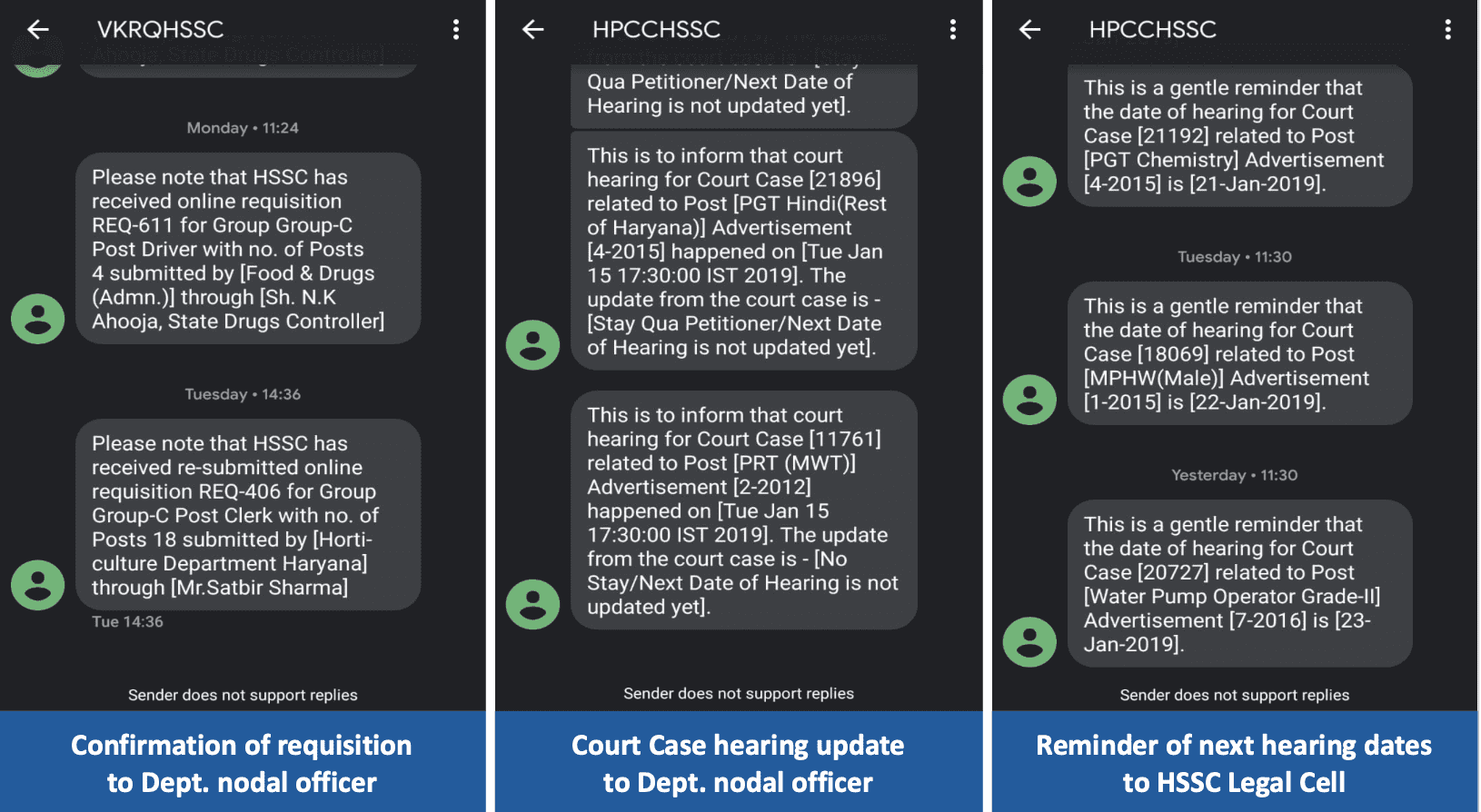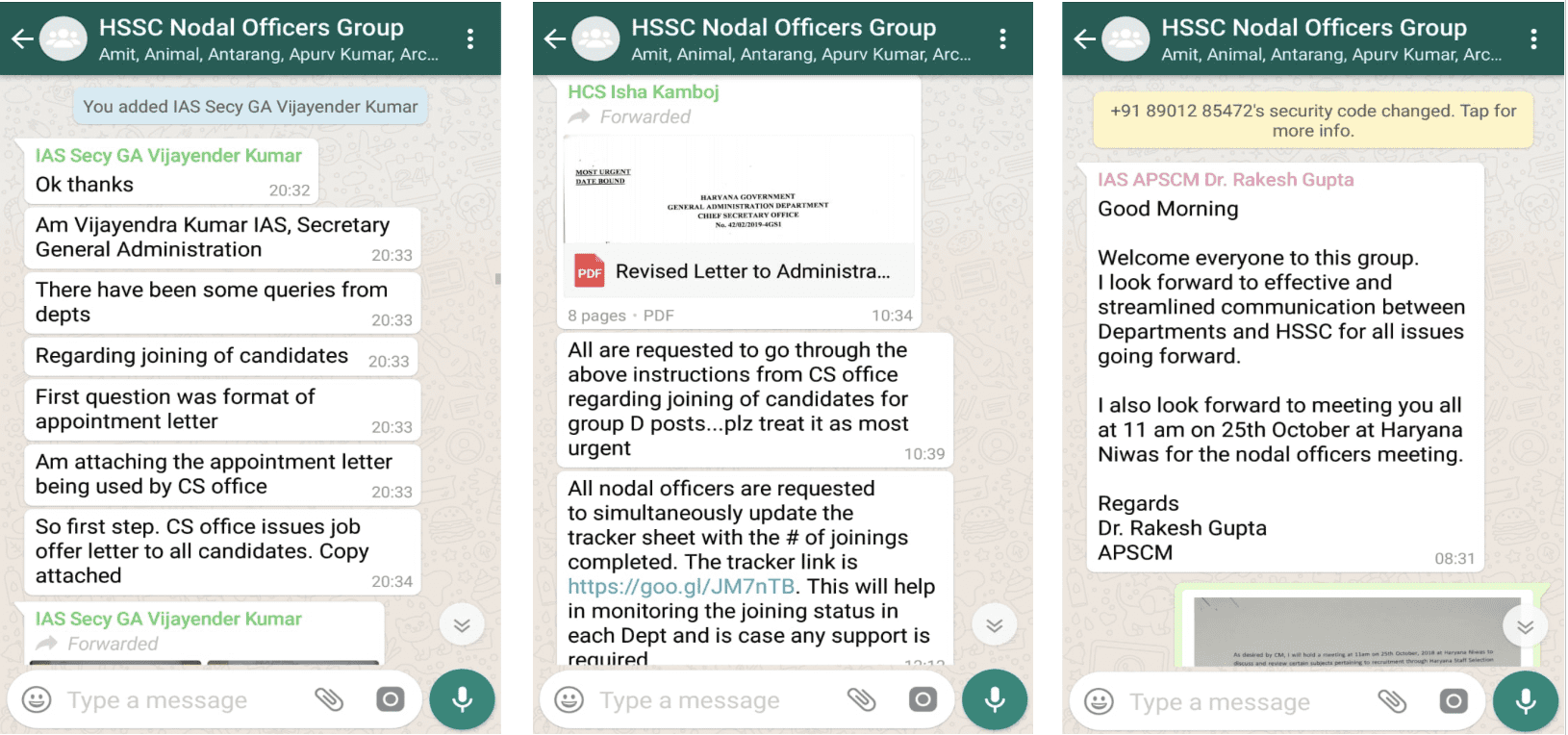Government jobs are highly coveted primarily by the youth primarily because of job security, stable salaries and the perceived respect that comes with holding a job. Government jobs in Haryana are classified into 4 groups, with Groups A and B being managerial posts and Groups C and D being execution posts. Group D posts typically consist of posts like driver, peon, gardner and so on. However, in Haryana, the traditional recruitment process for Group D positions—encompassing roles such as gardeners, peons, and cooks—was rife with inefficiencies. From 2004 to 2017, the Government of Haryana could only fill ~78,500 positions for these roles. Samagra, in collaboration with the Government of Haryana under the Saksham Haryana Skills and Employment Program, embarked on a mission to reform this system. The result? A systemic transformation that not only addressed the critical challenges but unlocked government recruitment for Haryana in the years that followed, allowing for over 75,000 positions to be filled from 2017-2020.
The Challenge: A System in Distress
The recruitment landscape for Group D posts was fraught with systemic inefficiencies, leaving room for corruption and delays. Key issues included:
- Lack of Objectivity: Interviews for junior-most positions allowed discretionary decision-making, leading to favoritism and rent-seeking behavior.
- Lack of Capacity: The Haryana Staff Selection Commission (HSSC) struggled with understaffing and relied heavily on manual, time-consuming processes to carry out the recruitment process.
- Lack of Accountability: Without mechanisms to track recruitment stages, the system lacked transparency, leaving applicants and departments in the dark on the status of recruitment.
- Lack of Transparency: Opaque procedures frequently resulted in court cases, stalling hiring and further complicating the recruitment cycle.
These inefficiencies not only delayed hiring but also eroded public trust in the system.
The Solution
Addressing the systemic challenges of Group D recruitment required a multi-faceted strategy that reimagined the process from the ground up. The Government of Haryana, with Samagra’s support, implemented a four transformative interventions, encompassing policy reforms, organisational restructuring, process optimisation, and technological integration.
1. Policy Reforms
Policy changes served as the foundation for this transformation. With the Group D Employees Amendment Bill, 2018, Haryana introduced uniform service rules which were enacted to standardise recruitment criteria across 74 departments and 117 posts. Before this, each department had its own set of rules, leading to inconsistencies in eligibility criteria, pay scales, and qualifications. The new rules ensured parity and simplicity, making the system more navigable for applicants and administrators alike. This also allowed the HSSC to introduce a common exam for similar positions across departments instead of having to conduct separate exams for each department.
Uniform Service Rules of Group D posts
Besides this a decision was made to scrap interviews for Group C and Group D positions. Interviews, previously a significant part of the recruitment process, had become a gateway for discretion and favoritism. Eliminating them ensured that selections were merit-based, relying solely on objective evaluation criteria. This move was a significant step toward reducing rent-seeking behavior and increasing trust in the system.
Chief Secretary order for scrapping interviews for Group C & D posts
2. Organisational Restructuring
The structural backbone of the recruitment system also underwent significant changes. The Haryana Staff Selection Commission (HSSC) saw the creation of a pivotal role: the Controller of Examination (CoE). This position was filled by a senior Haryana Civil Services officer responsible for managing every aspect of the recruitment process, from logistics to security and scheduling. The CoE also acted as a liaison with the Chief Secretary’s and Chief Minister’s offices, ensuring timely resolution of bottlenecks.
Government Order notifying the creation of Controller of Examinations position
In addition, the legal cell within HSSC was strengthened to address the high volume of court cases that plagued the recruitment process. By improving legal capacity, the government could resolve disputes more efficiently, preventing delays in hiring. Daily scrum meetings involving senior officials from the HSSC, the Chief Secretary’s office, and other stakeholders created a robust mechanism for immediate problem-solving, particularly during critical phases of the recruitment cycle.
Scrum meeting with APSCM - Dr. Rakesh Gupta
3. Process Optimisation
One of the most transformative changes was the shift to online scrutiny of documents, a move that reduced the processing time from two months to just one week. Previously, candidates were required to travel to central locations, such as Panchkula, to submit their documents physically—a time-consuming and costly process. The digitisation of scrutiny not only expedited the process but also eliminated the logistical challenges faced by candidates.
Government Order for online scrutiny of selected candidates
Another major improvement was the introduction of a merit-based counseling process. For the first time, applicants could rank their preferences for departments and posts during the application stage. This ensured that their preferences were considered during allocation, provided their merit ranking allowed it. This innovation added a layer of personalisation and satisfaction to the recruitment process, aligning organisational needs with candidate aspirations.
4. Technological Integration
Technology became the linchpin of the reformed system, introducing unprecedented levels of transparency and efficiency. A web-based requisition module allowed government departments to submit hiring requests online and track their progress in real time. This system, integrated with the Chief Minister’s dashboard, provided senior officials with visibility into the recruitment process, enabling proactive decision-making.
An advertisement and court case management information system (MIS) further streamlined operations by linking requisitions with their associated legal cases. This ensured that departments could monitor the status of both recruitment and related court proceedings simultaneously, addressing a significant source of delays.
Tech development done for the HSSC
The introduction of an SMS-based communication system brought real-time updates to applicants and departments alike. Candidates received notifications about every stage of the process, from application receipt to final selection. For departments, reminders and updates ensured that deadlines were met and coordination remained seamless.
SMS notifications received by department officials
Operationalising Across Haryana
Implementing these interventions required meticulous planning and execution. The Chief Secretary’s office played a critical role in orchestrating the efforts, ensuring that all stakeholders—from district administrations to HSSC officials—were aligned.
Daily scrum meetings during the critical phases of recruitment provided a platform for resolving day-to-day issues in real time. These meetings, chaired by senior officials, ensured that no thread of the recruitment process was left unattended. WhatsApp groups were created for constant communication among nodal officers, enabling instant updates and issue resolution.
Whatsapp group leveraged for quick communication by officials
Exam management, often a logistical ordeal, was streamlined through careful coordination with district administrations and educational institutions. Exam centers were mapped for seating capacity, and security arrangements were made in collaboration with district collectors. In cases where other exams coincided with recruitment exams, schedules were adjusted to avoid conflicts. Even transportation logistics were addressed, with special trains sanctioned to accommodate the massive movement of candidates across the state.
After results were announced, the joining process was monitored meticulously to prevent delays. Within a day of the results being declared, selected candidates were notified via SMS to join their respective departments. Departments were briefed on the joining process, and an online tracker monitored progress until the exercise was complete. This level of coordination ensured that the recruitment cycle—from application to joining—was completed in record time.
The Impact
The impact of these reforms was both immediate and far-reaching, establishing a new benchmark for public sector recruitment. In a record-breaking effort, over 18,000 Group D positions were filled in just a few weeks, drawing more than 18 lakh applications and utilising 758 exam centers. This monumental exercise, touching virtually every village in Haryana, provided equitable employment opportunities to the state’s youth and underscored the inclusivity of the process.
Efficiency gains were a hallmark of the revamped system. Online document scrutiny and counseling processes significantly reduced recruitment timelines and eliminated redundancies, while also lowering costs for both the government and applicants. Transparency, previously a major challenge, was restored through innovative tools like real-time dashboards and SMS notifications, which kept applicants informed at every step. The introduction of a cascaded review mechanism ensured continuous monitoring, enabling swift resolution of bottlenecks and reinforcing public trust.
Beyond operational success, the intervention had profound social and political implications. The reforms not only enhanced job accessibility for Haryana’s youth but also showcased the government’s commitment to good governance and transparency. This achievement became a cornerstone of the state’s political narrative, with the ruling government highlighting the initiative as a testament to its dedication to empowering citizens.
Tweets from Shri Manohar Lal celebrating the success of Group D recruitment
Excerpts of coverage by local and national media
Conclusion: A Model for Governance Reform
The success of Haryana’s Group D recruitment reforms is a testament to the power of systemic change in governance. Through visionary leadership and collaborative efforts, the Government of Haryana and Samagra transformed a deeply flawed process into a celebrated success story. By leveraging technology, simplifying processes, and fostering accountability, the initiative created a replicable model for other states and sectors.
These reforms not only addressed the immediate challenges but also set the stage for a more efficient, transparent, and citizen-centric governance system. As Haryana continues to innovate, the Group D recruitment story stands as a beacon of what is possible when determination meets strategy—a story of systemic transformation that has unlocked opportunities for thousands and reshaped the future of public recruitment in India.
This blog is part of the Amrit Series, where we bring to you success stories of large scale impact through our work across domains and states. You can learn more about Group D Government Recruitment here.










